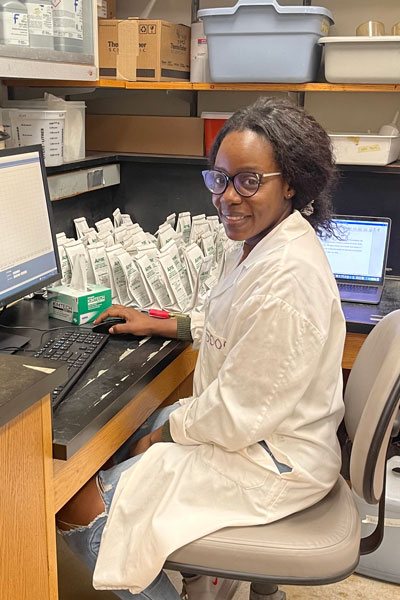
Shedding light on soil properties
USask graduate student research looks at advanced technologies to analyze and map soil properties.
By Jane CaulfieldThere’s a lot of information needed when determining what crops go in which field. From working with forecasted weather patterns to detailed crop rotations, producers need to collect a lot of data to make the best decisions for success. Some of the most vital information needed to make beneficial agricultural decisions comes from understanding what is in the soil.
However, traditional methods of understanding soil properties, such as field soil sampling and laboratory analysis, are known to be destructive, time-consuming, and expensive. It’s a perplexing problem PhD student Grace Gowera of the College of Agriculture and Bioresources has decided to tackle.
“My research looks at rapid ways of measuring soil properties, particularly soil organic carbon and soil salinity,” said Gowera. “Soil spectroscopy involves directing light to a soil sample and measuring how the light interacts with it. On the other hand, remote sensing using satellite images can be used to interpolate soil information. These technologies offer fast, non-destructive, and cost-effective way of analyzing and mapping soil properties.”
Supervised by Dr. Angela Bedard-Haughn (PhD) and Dr. Preston Sorenson (PhD), Grace’s focus is exploring how new technologies can enhance the overall process, ultimately improving outcomes for producers around the world.
“The study involves analyzing soil samples with varying compositions and understanding the relationship between soil spectral reflectance and soil properties using machine learning techniques,” said Gowera. “By utilizing these advanced methods, we gain a more accurate understanding of soil conditions and can then make informed decisions on soil management practices. The application of reflectance spectroscopy and remote sensing technologies for precision soil management holds significant promise.”
While Grace gathers data through a physical collection of soil from the field, she also examines data from satellite imagery using Google Earth Engine. She then relies on advancements made in machine learning for analysis to help producers identify and recognize patterns that inform predictions and inform agricultural decisions. From customized application of inputs that reduce costs, to improving yields, this research will provide benefits for the producer as well as the environment by improving operational practices over longer periods of time.
“This research has the potential to facilitate large-scale monitoring and management practices, enabling farmers and land managers to optimize their land use strategies, reduce input costs, enhance crop productivity, and foster sustainable agricultural practices,” she said.

Putting the results on a global scale
Originally from Zimbabwe, Grace said that her interest in agriculture comes from growing up on her grandparents’ farm.
“I always wondered why they spent so much time in the fields,” she said. “However, over time, I came to understand that the farm served as a vital source of income, food and employment. That sparked my interest in agriculture. As I delved deeper, I began to recognize the challenges they faced, which directly impacted crop productivity, such as water shortage and soil salinity.”
Through her research, she is keen to develop new approaches that can revolutionize agricultural practices around the world and enhance how producers manage their crops in a wide variety of climates and environments.
“Producers with enhanced soil management can make informed decisions on nutrient management, irrigation, and crop selection, leading to improved agricultural productivity,” she said. “Additionally, resource optimization can be achieved by tailoring inputs based on soil carbon and salinity levels, reducing waste, and improving economic efficiency andsustainability.”
While these advancements mean that producers can access vital information in more cost effective and efficient ways, the research Grace is doing also has the potential to help ensure there is a viable future for agricultural practices on a global scale.
“With the projected population growth and the consequent demand for increased food production, it is imperative to develop effective strategies for agricultural management,” she said. “The promotion of sustainable agriculture practices, such as minimizing soil degradation, conserving water resources, and reducing agrochemical use, can also be facilitated.”
More sustainable practices mean that we can limit the effects of climate change on agricultural outputs and, potentially, the global food supply.
“This research contributes to climate change mitigation by implementing soil carbon sequestration practices like cover cropping and organic amendments, thereby reducing greenhouse gas emissions and enhancing carbon sinks,” she said. “Furthermore, the early detection and intervention in soil salinity issues allow for timely measures such as improved irrigation techniques and the selection of salt-tolerant crops, mitigating potential productivity losses.”
Together, we will undertake the research the world needs. We invite you to join by supporting critical research at USask.

